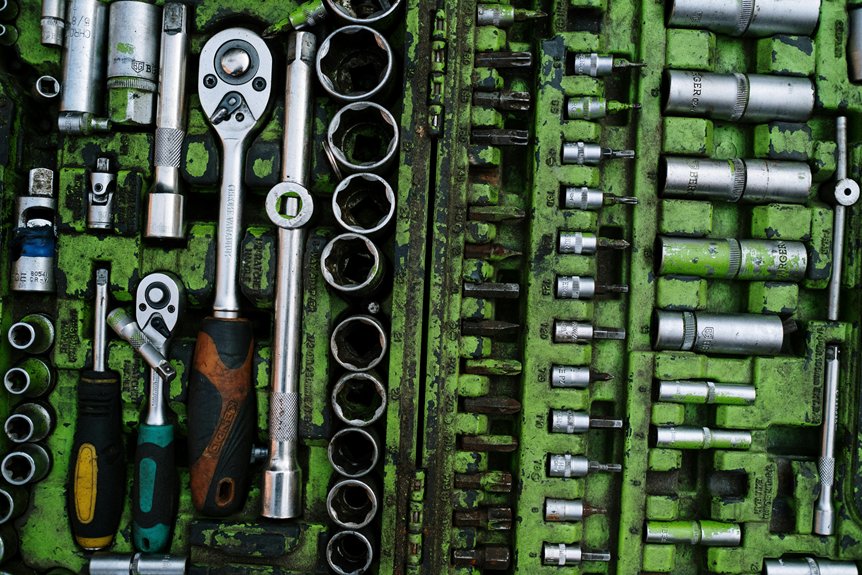Maintaining your home doesn’t have to be a challenging task. By implementing simple strategies, you can streamline upkeep and protect your investment. Establishing a maintenance schedule and prioritizing seasonal tasks can make a world of difference. You’ll find that tackling small repairs early on prevents bigger issues down the line. But that’s just the beginning—there are more effective tips to explore that can make home maintenance even easier.
Key Takeaways
- Establish a detailed maintenance schedule that includes monthly, quarterly, and annual tasks to keep your home in optimal condition.
- Create seasonal checklists to ensure timely completion of essential tasks, preventing larger issues from developing.
- Address minor repairs immediately to prevent escalation into costly problems, maintaining the integrity of your home.
- Invest in quality tools and professional services to enhance efficiency, safety, and the longevity of your home systems.
- Regularly review and adjust your maintenance strategies to fit your lifestyle changes and evolving home needs.
Establish a Maintenance Schedule

Establishing a maintenance schedule is essential for keeping your home in top shape throughout the year. By determining maintenance frequency for various tasks, you can prevent small issues from escalating.
Break down your schedule into monthly, quarterly, and annual tasks to guarantee nothing gets overlooked. Don’t hesitate to practice task delegation; if you live with others, assign responsibilities to share the load. This not only makes the process more manageable but also fosters teamwork.
Regularly review and adjust your schedule as needed, guaranteeing it fits your lifestyle and keeps your home in excellent condition without overwhelming you.
Prioritize Seasonal Tasks
After you’ve set up a maintenance schedule, it’s time to focus on the tasks that change with the seasons.
Once your maintenance schedule is in place, shift your attention to seasonal tasks to keep your home thriving year-round.
Start by creating a seasonal checklist that outlines essential tasks for each time of year, like cleaning gutters in the fall or prepping your HVAC system in the spring.
Always consider weather conditions—extreme heat or cold can impact your home’s systems.
By prioritizing these seasonal tasks, you’ll prevent bigger issues down the road and keep your home in top shape.
Stay proactive, and you’ll enjoy effortless upkeep, regardless of the season’s challenges.
Utilize Checklists for Efficiency
Using checklists can streamline your home maintenance routine, keeping you on track with weekly essentials and seasonal tasks.
By jotting down what needs to be done, you won’t forget important chores or let them pile up.
Plus, checking off completed tasks gives you a satisfying sense of accomplishment!
Weekly Maintenance Essentials
While it might seem like a chore, incorporating weekly maintenance tasks into your routine can save you time and money in the long run.
Focus on home safety with simple maintenance tips, like checking smoke detectors and testing carbon monoxide alarms. Schedule regular inspections of your home systems to catch potential issues early.
Create upkeep routines for routine cleaning and appliance care, ensuring everything runs smoothly. Don’t overlook preventive measures, which can greatly extend repair timelines.
Seasonal Task Reminders
Incorporating a seasonal checklist into your home maintenance routine can streamline your tasks and guarantee nothing gets overlooked.
These seasonal checklists serve as valuable maintenance reminders, helping you stay organized and proactive. Start by identifying key tasks for each season, like checking your HVAC system in spring or cleaning gutters in fall.
Break them down into manageable steps, and schedule reminders in your calendar. You’ll not only save time but also prevent costly repairs down the line.
Invest in Quality Tools
When it comes to home maintenance, investing in quality tools is a game changer. Not only do they guarantee safety and reliability, but they can also save you money in the long run by reducing the need for frequent replacements.
Choosing the right tools can make your tasks easier and more efficient, so let’s explore the essentials you should consider.
Essential Tool Investments
Investing in quality tools is essential for any homeowner looking to tackle maintenance tasks efficiently and effectively. High-quality tools not only make your projects easier but also last longer, saving you money over time.
Don’t forget about proper tool storage; keeping your tools organized and accessible guarantees you’re always prepared for any task. Regular tool maintenance is equally important; clean and inspect your tools frequently to prevent rust and wear.
Long-Term Cost Efficiency
While many homeowners might be tempted to save money by purchasing cheaper tools, opting for quality investments pays off in the long run.
Quality tools not only last longer but also enhance your energy efficiency and support effective preventative maintenance. Here are three reasons to invest wisely:
- Durability: Quality tools withstand wear and tear, reducing the need for replacements.
- Performance: They often perform better, making your tasks easier and quicker.
- Cost Savings: Investing upfront can save you money on repairs and energy bills, ensuring your home runs smoothly for years to come.
Safety and Reliability
Quality tools not only enhance your efficiency but also greatly boost safety and reliability during home maintenance tasks.
Investing in high-quality equipment guarantees that you meet reliability standards, reducing the risk of accidents. When you use durable tools, you’re less likely to experience malfunctions that could compromise your home safety.
Plus, reliable tools make it easier to complete tasks effectively, saving you time and effort in the long run.
Don’t compromise on quality; choosing the right tools can greatly impact your overall maintenance experience, keeping your home in top shape and your safety intact.
Invest wisely for peace of mind!
Tackle Small Repairs Promptly
When you tackle small repairs promptly, you not only maintain the integrity of your home but also prevent minor issues from snowballing into costly problems.
Recognizing repair urgency can save you time and money. Consider these quick fixes:
- Leaky Faucets: Replace washers or tighten connections to stop water waste.
- Drafty Windows: Use weatherstripping or caulk to improve energy efficiency.
- Squeaky Doors: Apply lubricant to hinges for a smoother operation.
Create a Home Inventory
Creating a home inventory is essential for protecting your investment and ensuring you’re prepared for any unexpected events.
Start by listing all your belongings, focusing on high-value items like electronics, furniture, and appliances. Use item categorization to organize your inventory efficiently—group items by room or type.
Don’t forget to include purchase dates, receipts, and photos for added documentation. This not only helps during insurance claims but also assists in tracking your possessions over time.
Regularly update your inventory, especially after significant purchases or changes, to maintain an accurate record and safeguard your home’s value.
Stay Organized With Digital Reminders

How can you keep track of your home maintenance tasks without the stress of forgetting them? Utilizing digital calendars and reminder apps can simplify your life considerably.
Here are three effective strategies to stay organized:
- Set Recurring Reminders: Use reminder apps to create notifications for routine maintenance tasks like changing air filters or checking smoke detectors.
- Sync with Digital Calendars: Integrate your maintenance tasks into your digital calendar for easy viewing.
- Prioritize Tasks: Use labels or color codes in your apps to highlight urgent tasks, ensuring you focus on what matters most.
This way, you’ll never miss a beat in your home upkeep!
Learn Basic DIY Skills
While you may feel overwhelmed by the idea of home repairs, learning basic DIY skills can empower you to tackle many maintenance tasks with confidence.
Start with simple woodworking projects like building shelves or repairing furniture; these skills will enhance your confidence and creativity.
Familiarize yourself with essential tools, such as hammers, screwdrivers, and saws, and practice basic home repairs like fixing leaks or patching walls.
Online tutorials and local workshops can provide valuable guidance.
Seek Professional Help When Needed
Knowing when to seek professional help can be just as important as mastering DIY skills. While tackling home maintenance tasks is rewarding, some situations require expert consultation.
Here are three scenarios where you should call in the pros:
- Home Inspection: If you’re buying or selling, an expert can identify hidden issues.
- Complex Repairs: For plumbing or electrical work, it’s safer to rely on licensed professionals.
- Regular Maintenance: Schedule annual inspections with specialists to keep your home in top shape.
Don’t hesitate to reach out when a task feels beyond your expertise—your home deserves the best care!
Conclusion
By implementing these simple strategies, you can transform home maintenance from an intimidating chore into an effortless routine. Establish a maintenance schedule, prioritize seasonal tasks, and tackle small repairs promptly to keep your home in top shape. Don’t forget to invest in quality tools and learn some basic DIY skills to boost your confidence. With a little organization and proactive planning, you’ll not only preserve your home’s integrity but also enhance its value for years to come.




